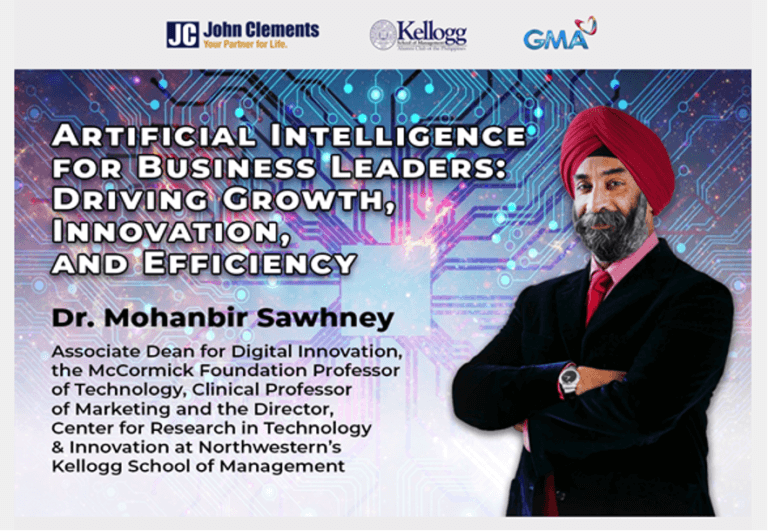Recognizing the need to equip business leaders with a deeper understanding of AI’s potential, Professor Mohan Sawhney conducted an enlightening workshop entitled “AI for Business Leaders: Driving Growth, Innovation, and Efficiency” last July 17, 2023 at the Dusit Hotel, Makati City. The workshop talked about various aspects of AI, including an introduction to AI and Generative AI, the significance of asking the right questions, and the importance of data governance and quality.
The workshop commenced with a comprehensive introduction to AI, tracing its evolution from its birth in the 1950’s to its present stage, which is more flexible and dynamic like ChatGPT4, which was just released this year. In the past, AI systems were limited by their inability to adapt to changing circumstances, offering the same answers to the same questions. However, recent advancements in AI, particularly in the fields of Machine Learning and Deep Learning, have transformed the landscape. Below is the list of AI‘s sub-types:
Artificial Intelligence (AI) – Software programs that can sense, reason, act and adapt. It performs tasks that normally require human intelligence, e.g., decision-making, visual perception. Examples of this are virtual personal assistants like Siri or Alexa, and fraud detection in banking transactions.
Machine Learning (ML) – A sub-type of AI that empowers systems to learn from data without explicit programming. These are algorithms whose performance improves as they are exposed to more data over time. It enables machines to recognize patterns, make decisions, and improve their performance over time based on the data they receive.
Deep Learning (DL) – A subset of machine learning in which multilayered neural networks are used to mimic the human brain. It takes inspiration from the human brain’s neural networks, utilizing multi-layered architectures to process and understand complex data.
Generative AI – A type of AI that can generate new data or products that look like they were produced by humans. It emerged as an exciting frontier within deep learning. It leverages deep learning techniques to generate new content. It learns patterns, structures, and rules from training data, and applies these to generate new, previously unseen data.
Professor Sawhney also discussed the significance of Transfer Learning, a technique that leverages knowledge from one task to improve learning in a related task. By transferring pre-existing knowledge, AI systems can adapt and excel in new tasks more efficiently, saving valuable time and resources.
Throughout the workshop, the importance of data governance was emphasized. With AI’s reliance on data, ensuring the proper management, security and ethical use of data are very much needed. Business leaders need to establish strong data governance frameworks to guarantee compliance and build trust among all stakeholders. Data hygiene, on the other hand, was another key aspect discussed. The accuracy and reliability of AI models depend on the quality of the data they are trained in. Clean, relevant and up-to-date data is vital to prevent biases and errors in AI-driven decision making processes.
One of the major takeaways from the workshop was the significance of asking the right questions and framing problems effectively. AI systems can only be as effective as the questions they are designed to answer. Business leaders must carefully articulate the problems they seek to solve and consider how AI can best assist in finding innovative solutions. Another concept we learned was prompt engineering. This involves fine tuning the prompts given to AI models to obtain reliable and accurate information.
In conclusion, Professor Sawhney’s workshop on AI for Business Leaders: Driving Growth, Innovation and Efficiency provided an in-depth exploration of AI’s potential and its relevance in shaping the future of business. Given today’s data-driven world, leveraging AI effectively can be the key differentiator between businesses that thrive and those that fall behind.





